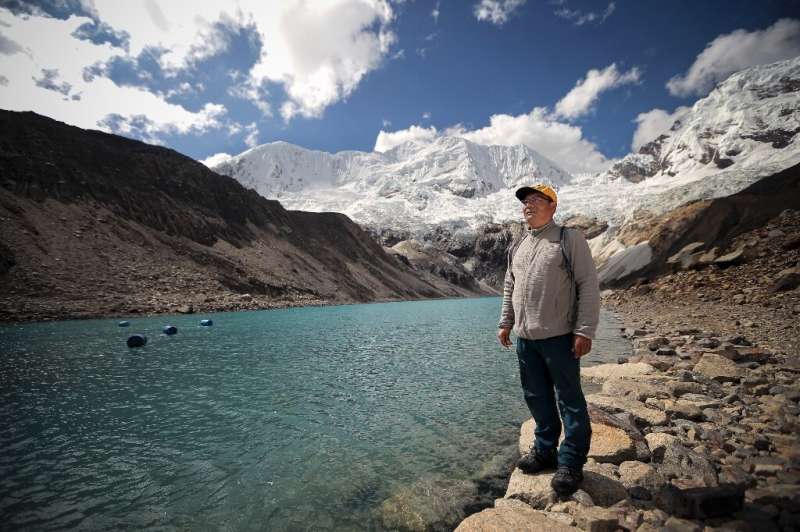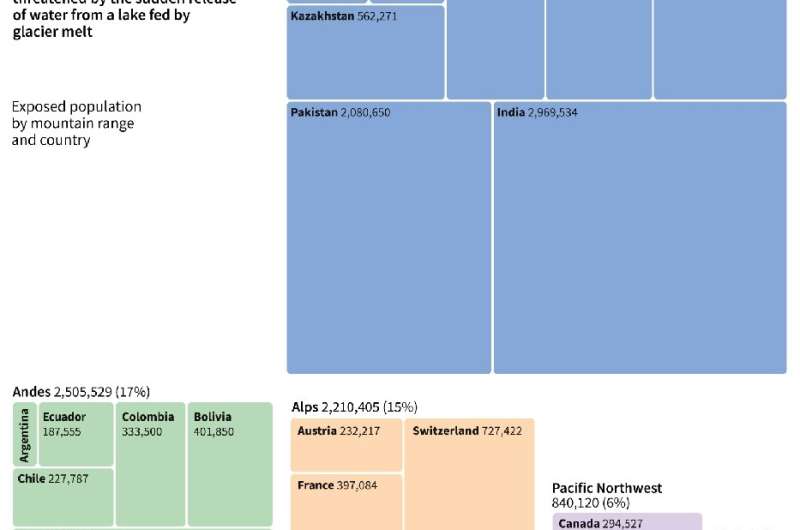Worldwide population exposed to glacial lake outburst floods.
Violent flooding from glacier lakes formed or enlarged by climate change threatens at least 15 million people worldwide, most of them in four countries, researchers said Tuesday.
More than nine million people across so-called High Mountain Asia live in the path of potential glacial lake outburst floods, including five million in northern India and Pakistan, they reported in Nature Communications.
China and Peru are also especially exposed to the danger of abrupt flooding from melting glaciers, according to the study, the first global assessment of areas most at risk.
The volume of lakes formed as glaciers worldwide disintegrate due to global warming has jumped by 50 percent in 30 years, according to a 2020 study based on satellite data.
Earth’s average surface temperature has risen nearly 1.2 degrees Celsius since preindustrial times, but high-mountain regions around the world have warmed at twice that pace.
Glacier lakes are particularly unstable because they are most often dammed by ice or sediment composed of loose rock and debris. When accumulating water bursts through these accidental barriers, massive flooding can occur downstream.
This kind of flooding has been responsible for thousands of deaths in the last century, as well as the destruction of communities, infrastructure and livestock.
“It’s not the areas with the largest number or most rapidly growing lakes that are most dangerous,” said lead author Caroline Taylor, a doctoral student at Newcastle University in England.
“Instead, it is the number of people, their proximity to a glacial lake, and, importantly, their ability to cope with a flood that determines the potential danger,” she explained.

…
2023-02-11 10:00:01 Glacier lakes swollen by global warming threaten millions
Original from phys.org
Global warming is leading to an alarming reality: higher temperatures are causing glacier lakes swollen to dangerous levels. These glacier lakes are a major source of water for millions of people around the world, and the increased glacial melt caused by global warming is threatening the stability of these communities.
Glacier lakes are freshwater bodies of water situated at the base of glaciers. They are home to unique ecosystems and species that rely on the cold glacial water for their survival. Due to increasing temperature, the amount of snowmelt at the top of glaciers is increasing, leading to an increased amount of water flowing from the glaciers into the glacier lakes. This increased volume of water threatens to overflow the glacier lakes and cause flooding downstream, putting communities at risk of damage or destruction.
As the glaciers continue to melt over time, the already rising water levels in the glacier lakes will become even higher, compounding the risk of flooding to nearby communities. The meltwater also contains large amounts of sediment, which can damage the ecosystems of the glacier lake regions. These effects can be compounded further by human activity that can increase flooding, such as the construction of dams and diversion of water from other sources.
The threat to glacier lake communities is very real and it’s only going to get worse as global warming continues. The increasing water levels put the lives of millions of people at risk and can lead to economic damage for those affected. In order to protect these communities, it is crucial that governments intervene to reduce their carbon emissions in order to mitigate the effects of climate change. It is also critical that these communities have access to the resources necessary to create resilient infrastructure that can withstand flooding from swollen glacier lakes. Only then can these communities be saved from the looming threat posed by global warming.




















